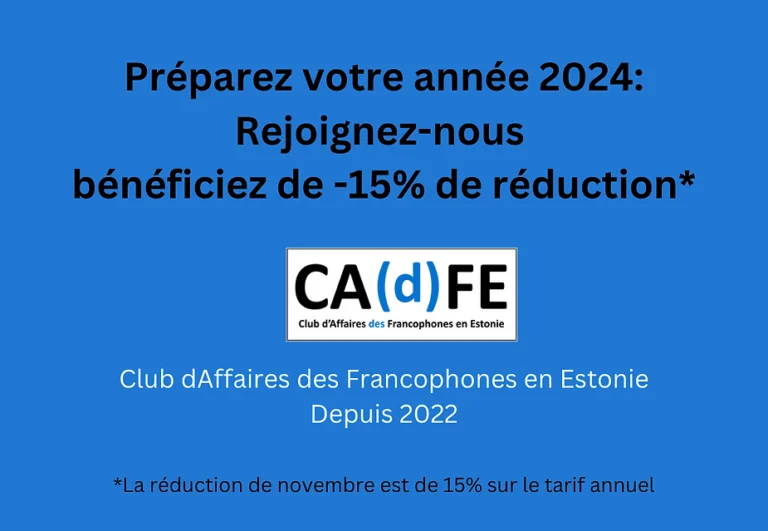
What is the Business Club, soon to be a Chamber of Commerce, doing for Estonian francophones?

In the complex, interconnected world of business, organizations such as French business clubs and chambers of commerce play a central role in fostering business growth and success.
These entities are essential support systems that enable businesses to thrive and grow.
Whether you’re a savvy entrepreneur in Estonia, a French-speaking business owner or simply intrigued by the dynamics of the French business world, it’s essential to understand the complex functions and benefits of these organizations.
What is a French Chamber of Commerce?
The role of French chambers of commerce in economic growth
French Chambers of Commerce, also known as Chambres de Commerce et d’Industrie (CCI), have played a key role in economic growth in France for decades.
These chambers are the cornerstone of support for businesses operating in France, and have extended their influence to several countries, including Estonia.
The foundation of a French Chamber of Commerce lies in its commitment to fostering international trade and economic growth.
These chambers act as connectors between local companies and international markets, fostering opportunities for global expansion and business development.
In Estonia, this role is fulfilled by CAdFE, which works closely with local entrepreneurs to facilitate trade and strengthen economic ties with France and the local ecosystem.
What is a French Business Club?
The role of French business clubs in networking and support
French business clubs are an essential part of the business landscape.
These clubs are dynamic communities where entrepreneurs and professionals come together to network, collaborate and promote their businesses.
These are the first steps a Chamber of Commerce must take before launching.
The economic impact of French business clubs
French Business Clubs are not just about networking; they are key drivers of economic growth in the regions where they operate.
By facilitating connections and collaborations, these clubs create opportunities for business expansion, knowledge sharing and innovation.
These clubs foster a sense of belonging and create an environment in which members can network, share ideas and explore business opportunities.
The impact of these clubs extends beyond economic growth; they also contribute to cultural exchange and community development.
Through events, seminars and networking sessions, business clubs provide platforms for individuals from diverse backgrounds to connect, share experiences and forge lasting relationships.
What business support services do chambers of commerce and business clubs offer?
A multifaceted approach to business support
The French Chambers of Commerce offer a comprehensive range of services covering different aspects of business operations.
These services are designed to support companies at different stages of their growth and development.
Business development services are another important offering from these chambers.
These encompass a range of activities, from offering advice on setting up a business in Estonia to facilitating networking opportunities with local entrepreneurs.
They are able to do this because their size allows them to employ dedicated staff.
Currently expanding, CAdFE plans to offer more services in the near future.
Networking plays an important role in business development.
CAdFE, for example, fosters relationships by organizing events where entrepreneurs from different regions can connect, exchange ideas and explore opportunities for collaboration.
These events go beyond exchanging business cards; they are opportunities to build lasting relationships based on trust and shared business interests.
All are the result of the volunteer work of the Board of Directors.
Support for Entrepreneurs and Startups
For entrepreneurs and startups, the support offered by French Chambers of Commerce can be particularly transformative.
Many chambers offer mentoring and coaching programs that pair experienced professionals with budding entrepreneurs.
These mentor-mentee relationships provide invaluable guidance, advice and support, helping mentees meet the challenges of starting up and growing a business.
This service is already provided by CAdFE and is free of charge for its members.
This individual support system enables entrepreneurs to maximize their potential, improve their decision-making skills and optimize their business operations.
Educational initiatives and training
Businesses, whether start-ups or well-established enterprises, need to constantly adapt to an ever-changing commercial landscape.
French Chambers of Commerce recognize this need and organize programs and workshops covering a wide range of topics, including marketing, finance, legal issues and technology.
These educational initiatives equip members with the knowledge and tools they need to stay competitive and seize new opportunities.
In a world where technology and markets are constantly evolving, it’s vital to keep abreast of industry trends and best practices.
How do chambers and business clubs work with governments?
The advocacy role of chambers and business clubs
One of the key roles played by French Chambers of Commerce and Business Clubs is their active interaction with government bodies.
These organizations serve as vital bridges between business and government, working diligently to create a favorable environment for business operations and advocating the needs of companies.
These chambers and clubs often act as a collective voice for the business community, ensuring that the concerns and aspirations of entrepreneurs are taken into account when government policies and regulations are formulated.
This advocacy role plays a decisive role in creating an enabling business environment.
Partnerships with governments: a case study
In Estonia, the partnership between CAdFE and the French embassy is a striking example of how these organizations work with governments to promote trade relations and economic growth.
CAdFE and the French Embassy work closely together on various initiatives aimed at strengthening economic ties between France and Estonia.
One notable aspect of this collaboration is the organization of trade missions.
These missions enable companies from both countries to explore new markets, establish contacts and seek out potential collaboration partners.
Conclusion
In conclusion, French business clubs and chambers of commerce, including entities such as CAdFE, are indispensable elements of the business landscape in Estonia and various other countries.
They offer a wide range of support services, making them invaluable to entrepreneurs and business owners.
Their role as intermediaries between business and government ensures that the needs and interests of the business community are well represented.
Whether you’re an entrepreneur in Estonia or an international business owner looking to connect with companies in France, Belgium, Switzerland, Canada, Morocco or other French-speaking regions, these organizations are essential for networking, support and access to resources.
By understanding what these organizations do and how they work, companies can make the most of the resources and opportunities they offer, ensuring their growth and success in the French-speaking world of business.
Whether in France, Estonia or other regions, these organizations are indispensable for navigating the dynamic, interconnected world of business.
If you’re a French speaker living in Estonia, or an Estonian entrepreneur looking to develop your business in French-speaking countries, if you’re passionate about networking, business growth and connecting with like-minded professionals… look no further!
CAdFE, the exclusive business club for French speakers in Estonia, and the future International Chamber of Commerce, are delighted to invite you to join our dynamic and lively business community.
What we offer:
-
Networking galore
-
Perspectives and trade conferences
-
Business coaching and mentoring
-
Spirit of collaboration
-
Social and cultural events
Find out more about CAdFE: https://www.cadfe.ee/about-us
Find out who our members are: https://www.cadfe.ee/members
Become a member: https://www.cadfe.ee/membership
Contact us!

✉ contact@ccife.ee
CCI France-Estonie is proudly affiliated to CCI France International, the worldwide network of French Chambers of Commerce and Industry.
Download the CCIFI Connect application
Accelerate your business thanks to the 1st private network of French companies in 94 countries: 119 chambers | 33,000 companies | 4,000 events | 300 committees | 1,200 exclusive advantages
Exclusively for members of the CCI Françaises à l’International, discover the CCIFI Connect app.
Website
Stay informed!
Made with ❤ by Cycoma
Copyright 2024 Chambre de Commerce et d’Industrie France Estonie
Contact us!

✉ contact@ccife.ee
CCI France-Estonie is proudly affiliated to CCI France International, the worldwide network of French Chambers of Commerce and Industry.
Download the CCIFI Connect application
Accelerate your business thanks to the 1st private network of French companies in 94 countries: 119 chambers | 33,000 companies | 4,000 events | 300 committees | 1,200 exclusive advantages
Exclusively for members of the CCI Françaises à l’International, discover the CCIFI Connect app.
Website
Stay informed!
Made with ❤ by Cycoma
Copyright 2024 Chambre de Commerce et d’Industrie France Estonie























